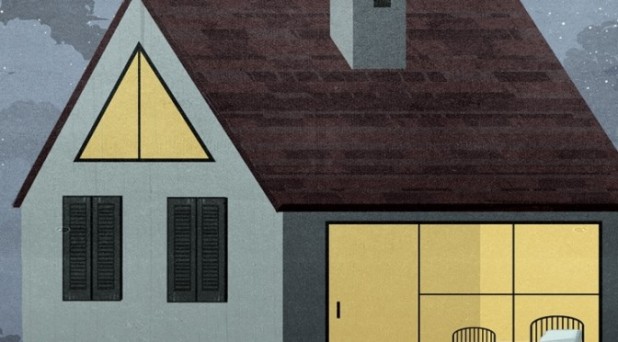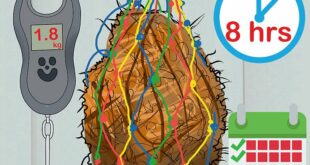Steve Sailer
VDARE
October 29, 2015
From National Journal:
BY BRIAN RESNICK
An unexpected challenge in the quest for racial justice, October 23, 2015
… Generally, people are thought to spend 20 percent of their night in slow-wave sleep, and the study’s white participants hit this mark. Black participants, however, spent only about 15 percent of the night in slow-wave sleep.
The study was just one data point in a mounting pile of evidence that black Americans aren’t sleeping as well as whites. This past June, the journal Sleep published a study on the sleep quality of black, white, Chinese, and Hispanic adults in six cities across the United States. …
The results? “The insufficient amount of sleep, the short sleep duration of the African-Americans really stood out,” says Susan Redline, a Harvard professor of sleep medicine and one of the study’s co-authors. “It really emphasized that African-Americans, as a group, are getting the least amount of sleep compared, at least, to the three other groups.” Whites in the study slept an average of 6.85 hours; blacks slept an average of 6.05 hours.
Studying a 669-person cohort in Chicago—44 percent were black; the rest were white—she and her colleagues found, on average, an hour difference between blacks’ and whites’ sleep.
ON THE QUESTION of how to explain the black-white sleep gap itself, researchers have a number of related theories. (There is a consensus that innate biological differences between blacks and whites are not a factor.)
My impression is that individual sleep patterns are pretty idiosyncratic, so I’m not aware of strong racial differences. In theory, however, it seems possible that people whose ancestors evolved in tropical climates where only mad dogs and Englishmen don’t nap during the noonday sun would be less well-suited to the Anglo-American schedule of 16 hours up without a nap followed by 8 hours down than would people whose ancestors invented that schedule.
The stress caused by discrimination is one strong possibility. …
After the participants’ stays in the San Diego lab, researchers had them take a survey, designed to assess the level of discrimination they felt on any given day. (Participants were asked to agree or disagree with statements, including “In my life, I have experienced prejudice because of my ethnicity” and “My ethnic group is often criticized in this country.”) Armed with this information, Tomfohr and her colleagues could then determine a correlation between discrimination and sleep. And it turned out that there was, in fact, a correlation: More discrimination meant less slow-wave sleep. “If you can take out that discrimination piece, the average African-American and the average Caucasian look at lot more similar,” she says. “It’s not perfect, but in terms of sleep, a lot of the disparity goes away.”
Danielle L. Beatty Moody, a psychologist at the University of Maryland, Baltimore County, conducted a similar test while working as a post-doctoral scholar in the psychiatry department of the University of Pittsburgh in the late 2000s. People who are discriminated against, she believes, carry worry throughout the day. And that worry literally keeps them up at night. “It’s uncomfortable for them to sleep because they are thinking back over mistreatment, thinking back over maltreatment, thinking back over bias they experienced,” she says. “In thinking about those experiences, they are getting more aroused, more cognitive arousal, which does the opposite of what you need it to do to go to sleep.”
Think of how much even more of a genius Ta-Nehisi Coates would be if only he weren’t up all night obsessing over what that white lady on the escalator really meant when she said, “Come on!”
Neighborhoods also appear to matter when it comes to sleep health. “I have never seen a study that hasn’t shown a direct association between neighborhood quality and sleep quality,” Hale tells me. “Those two are linked.” …
Feelings of safety are key here. Hale theorizes that—as with discrimination—noisy, unsafe, disorderly neighborhoods increase stress and the need for vigilance. “If you know somebody in your neighborhood who has had a break-in, you might feel pretty uncomfortable shutting your eyes falling asleep while your two or three children are sleeping in the room next door and no one else is there to protect them,” she says. “And that type of insecurity, whether it’s financial or physical safety, is more common among people who don’t have control over their environment, because if you did have control over your environment, you’d say, ‘I’m getting out of here.’ ”
Hale has been involved in several studies that compare levels of disorder in a neighborhood—as measured by cleanliness, crime, presence of graffiti, and so on—with sleep and health. Overall, she finds, poor sleep can explain 20 percent of the difference between the good health found in rich neighborhoods and the bad health found in poor ones. “Based on these results, targeted interventions designed to promote sleep quality in disadvantaged neighborhoods (e.g., community-based sleep promotion and noise level ordinances) could help to improve the physical health of residents in the short-term,” Hale writes in one of her co-authored papers in the journal Preventive Medicine.
Obviously, the solution to black people sleeping poorly for fear of crime is to let huge numbers of black criminals out of prison.
No, wait, the solution, according to Raj Chetty, is to have black people move to Salt Lake City.
Seriously, as everybody knows, although of course it’s not mentioned in this article, black neighborhoods, at least before everybody moves out, tend to be LOUD.
Over time, fortunately, technology is making it easier to sleep in loud neighborhoods, which is one reason white people are moving back downtown. Fans and air conditioning let you sleep more often with the windows shut, and double pane windows cut the decibels coming through the windows dramatically. (The decline in car alarms along with the decline in car theft has been a boon to city dwellers. Many of my most vivid memories of living in Chicago in the 1980s and 1990s involve car alarms.)
A much, much cheaper innovation are better earplugs. If you haven’t tried a few different kinds of earplug yet, please don’t dismiss them. I refused for years to try earplugs on the grounds that they would obviously keep me from falling asleep. Finally, in Ireland in 1994 when my flight got delayed for 24 hours due to the crew being still drunk the morning after Ireland’s 1-0 World Cup victory over defending champion Italy and all the passengers had to share rooms, I tried them and, boom, next thing I knew I was waking up 8 hours later.
There are various kinds of foam earplugs, and different ones appeal to different people. The cone-shaped slick foam earplugs appear to be very popular judging by how many facings there are in the drug store, but I can’t stand them compared to the less popular cylindrical rough foam ones. But that’s just me.
Another way, that’s also not mentioned in this article, for blacks to get more sleep is to turn off the TV.
Blacks, kids and adults alike, watch huge amounts of television. Here’s a 2011 press release from Northwestern U. about a study on young people:
STUDY: STARK DIFFERENCES IN MEDIA USE BETWEEN MINORITY, WHITE YOUTH June 8, 2011 | by Wendy Leopold
EVANSTON, Ill. — Minority youth aged 8 to 18 consume an average of 13 hours of media content a day — about 4-1/2 hours more than their white counterparts, according to a Northwestern University report, the first national study to focus exclusively on children’s media use by race and ethnicity.
“In the past decade, the gap between minority and white youth’s daily media use has doubled for blacks and quadrupled for Hispanics,” says Northwestern Professor Ellen Wartella, who directed the study and heads the Center on Media and Human Development in the School of Communication. “The big question is what these disparities mean for our children’s health and education.”
The report finds that minority children spend one to two additional hours each day watching TV and videos, approximately an hour more listening to music, up to an hour and a half more on computers, and 30 to 40 minutes more playing video games than their white counterparts.
The only medium for which no difference was found between minority and white youth was reading print for pleasure. Young people in all groups read for pleasure approximately 30 to 40 minutes a day, the study finds.
“Our study is not meant to blame parents,” says Wartella, a longtime Sesame Workshop trustee and Hamad Bin Khalifa Al-Thani Professor in Communication.
That sounds like the name of an endowed chair made up by Michel Houellebecq.
… The study, “Children, Media and Race: Media Use Among White, Black, Hispanic and Asian American Children,” is based on a new analysis, by race, of data from the Kaiser Family Foundation’s previous media use studies. It finds that race-related differences among youth are robust even when controlling for factors including parent education and whether or not children are from single- or two-parent families.
Other report findings:
• Minority youth are especially avid adopters of new media, spending about an hour and a half more each day than White youth using their cell phones, iPods and other mobile devices to watch TV and videos, play games, and listen to music (a total of 3 hours and 7 minutes, or 3:07 in mobile media use among Asians, 2:53 among Hispanics, 2:52 among blacks, and 1:20 among whites).
• Traditional TV viewing remains the most popular of all media — with black and Hispanic youth consuming an average of more than three hours of live TV daily (3:23 for blacks, 3:08 for Hispanics, 2:28 for Asians and 2:14 for whites).
• TV viewing rates are even higher when data on time-shifting technologies such as TiVo, DVDs, and mobile and online viewing are included. Total daily television consumption then rises to 5:54 for black youth, 5:21 for Hispanics, 4:41 for Asians, and 3:36 for whites.
• Black and Hispanic youth are more likely to have TV sets in their bedrooms (84% of blacks, 77% of Hispanics compared to 64% of whites and Asians), and to have cable and premium channels available in their bedrooms (42% of blacks and 28% of Hispanics compared to 17% of whites and 14% of Asians).
• Minority youth eat more meals in front of the TV set — with 78% of black, 67% of Hispanic, 58% of white and 55% of Asian 8- to 18-year-olds reporting that the TV is “usually” on during meals at home.
• Trends such as TV sets in the bedroom and eating meals with the TV on begin at an early age. Black children under 6 are twice as likely to have a TV in their bedroom as whites and more than twice as likely to go to sleep with the TV on. Black children under 6 are almost three times as likely to eat dinner in front of the TV than white children the same age.
• Asian youth spend more time in recreational computer use: nearly 3 hours a day (2:53) compared to just under 2 hours for Hispanics (1:49), nearly 1-1/2 hours for blacks (1:24) and slightly less for whites (1:17). …
 Daily Stormer The Most Censored Publication in History
Daily Stormer The Most Censored Publication in History



